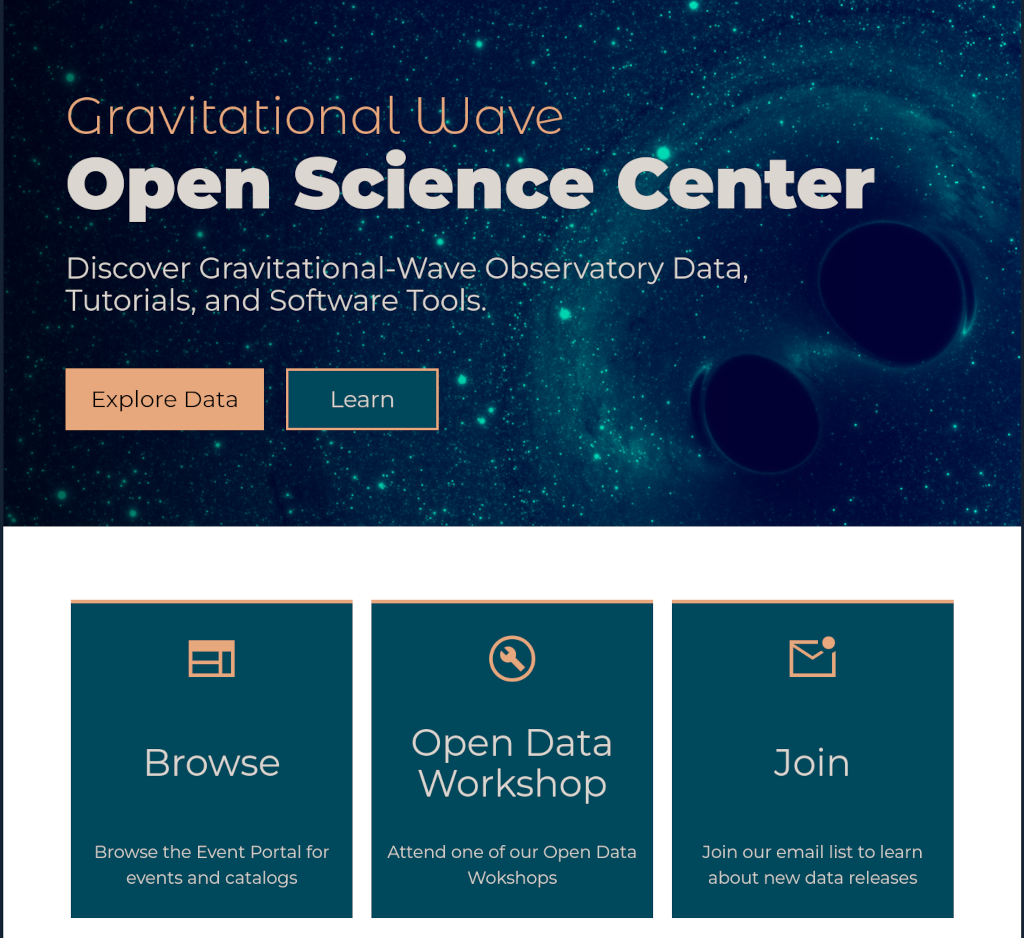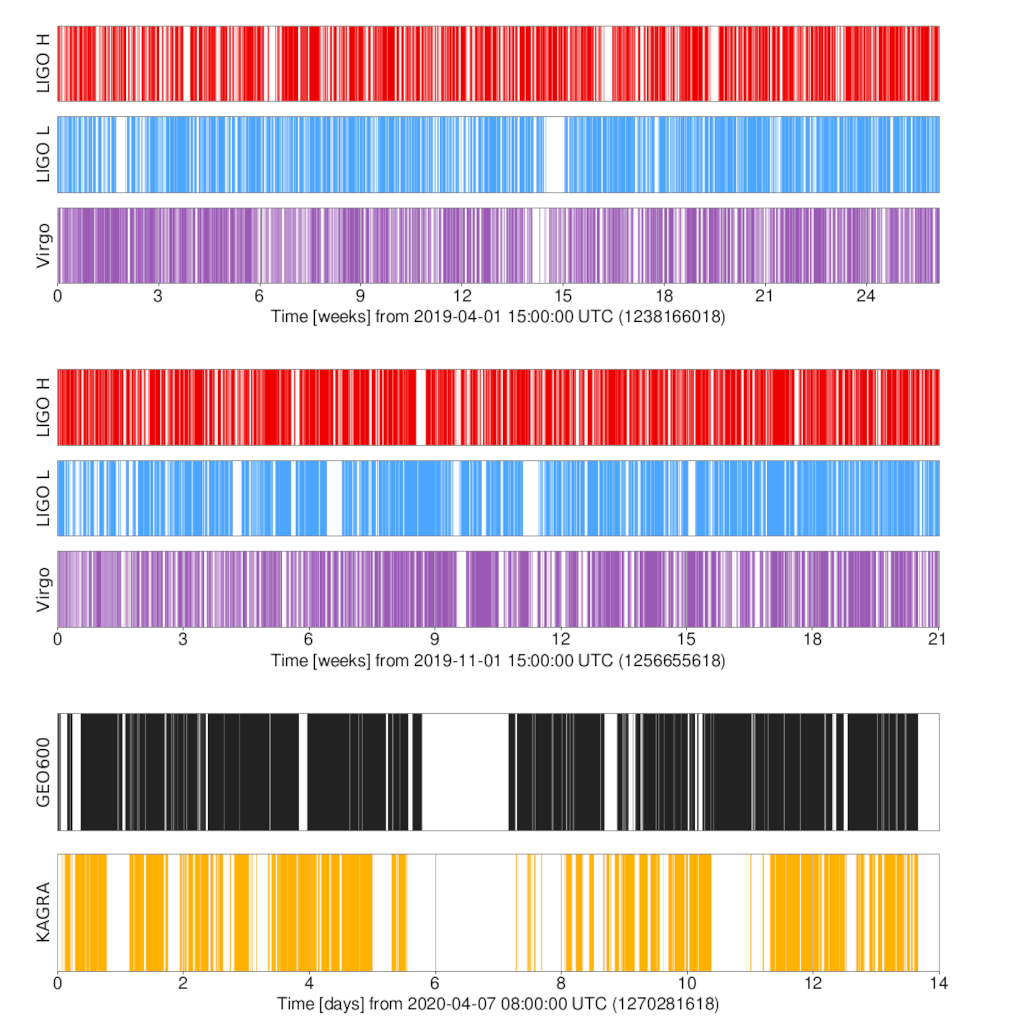In its data management plan, the LIGO–Virgo–KAGRA Collaboration (LVK) has committed to the principles of open science. Following this decision, key science data products are made available to the public on the Gravitational Wave Open Science Center (GWOSC) website at gwosc.org.

Figure 1: Home page of the Gravitational Wave Open Science Center (GWOSC) at https://gwosc.org
The article provides a thorough description of the latest major data set publicly released, associated with the third observing run, O3, that took place from April 1 2019 to April 21 2020. The bulk of this observing run collected data is from the Advanced LIGO and Advanced Virgo detectors. The period is divided into two main operational phases: O3a from April 1 2019 to October 1, 2019 and O3b from November 1, 2019 to March 27, 2020 with a one-month maintenance break between the two phases. A third and final observation phase, known as O3GK, was performed by the detectors KAGRA and GEO600 from April 7 to April 21, 2020. Previous major data releases from the first and second observing runs O1 and O2 of Advanced LIGO and Advanced Virgo were published in this article.

Figure 2: Timelines for the full O3a (top), O3b (middle) and O3GK (bottom) observing runs. Colored bars represent times when the detectors, namely LIGO in Hanford, Washington (US), LIGO in Livingston, Louisiana (US), Virgo in Cascina close to Pisa (Italy), GEO600 in Sarstedt close to Hanover (Germany), KAGRA in Kamioka, Gifu (Japan), were up and taking good data while white areas show times when data are not available. Click on the figure for a larger version.
Everything you always wanted to know about gravitational wave data (but were afraid to ask)!
Through this article, readers gain insight into the data. This includes how the release data format was obtained from raw measurements through a process known as calibration; and how the data were curated through filtering and cleaning to make them usable. Moreover we describe how the data are stored in the files that are released to the public. Finally, we give pointers to software tools that can be used to access and use the data.
GWOSC gives access to two main types of data. First, it provides recordings of the detector arm length difference, which is a measure of the strain of passing gravitational waves. This consists of time series associated with either the full months-long observation period with an indicator of data quality at any time. For convenience, shorter, one-hour snippets around detected gravitational wave signals are also provided.
Second, the GWOSC “event portal” provides an electronic version of the GWTC catalogs that collects all gravitational signals detected in the data by the LVK teams (also called “events”). This database is searchable and can be accessed programmatically. That may turn out to be convenient as the number of events is large, with about 80 new detections made during the observation run O3. The GWTC catalogs are cumulative: the GWOSC event portal contains events from O1, O2 and O3 which together make up the GWTC-3 catalog. However our catalog papers usually focus only on the newest additions in each catalog release, as e.g. described here for the most recent events (from O3b).
We explain how public data release follows the so-called FAIR Guiding Principles for scientific data management and stewardship. This ensures that the data are made Findable (i.e., discoverable through the GWOSC web server), Accessible (i.e., can be downloaded directly from the web interface, or from other channels such as CernVM-FS and the network data server NDS2), Interoperable (using international standards such as HDF5, that are compatible with open source softwares) and Reusable (thanks to a rich documentation and metadata, released with a license, ensuring they may be freely reused with minimal restrictions).
Now, your turn!
The purpose of this data release is to allow the reproducibility of the analyses performed by the team of the LVK and to increase the impact of the data through its wider use. So, you are welcome to use the O3 data as many researchers around the world do already. If you happen to do so, don’t forget to acknowledge the use of the data and to make a citation to this article. Free workshops are organized regularly to train interested persons on using public data. Feel free to join!
Find out more
- Visit our websites:
- Gravitational Wave Open Science Center: gwosc.org
- Detailed usage notes about the strain data, calibration, data quality, and more: https://gwosc.org/yellow_box/
- GWOSC tutorials: https:/gwosc.org/tutorials/
- Read a free preprint of the full scientific article here or on arXiv.org

